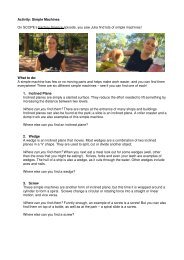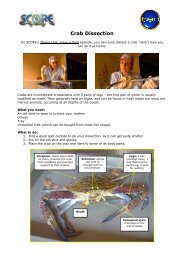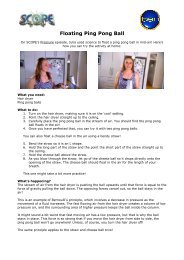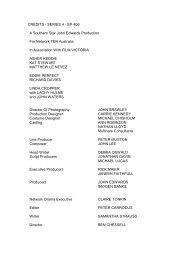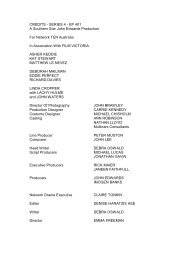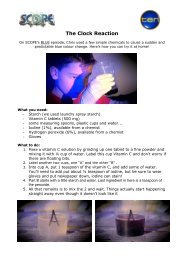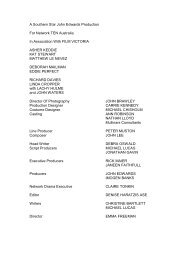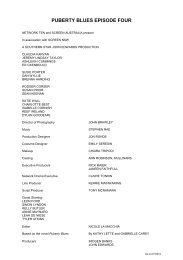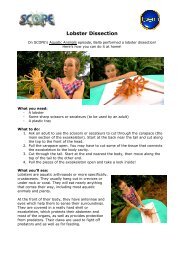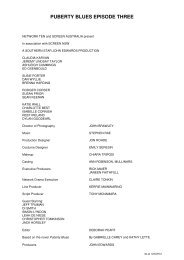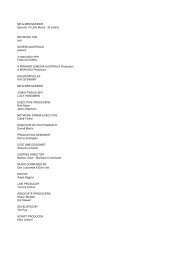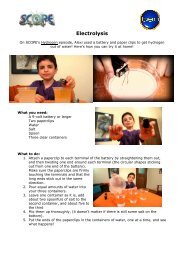Create successful ePaper yourself
Turn your PDF publications into a flip-book with our unique Google optimized e-Paper software.
<strong>Cyclone</strong> <strong>in</strong> a <strong>Bottle</strong>!<br />
On SCOPE's SIMULATIONS episode, Elizabeth creates a cyclone <strong>in</strong> a bottle and even<br />
makes it glow <strong>in</strong> the dark!<br />
What you need:<br />
- 2x large plastic bottles<br />
- Tape<br />
- Glue<br />
- Drill<br />
- Water<br />
- Glitter<br />
- Tonic water<br />
- A black light globe<br />
What to do:<br />
1. Start off by stick<strong>in</strong>g two bottle caps back to back us<strong>in</strong>g strong glue; also, tape<br />
them together once the glue has dried<br />
2. Ask an adult to drill a hole <strong>in</strong> the middle of the caps us<strong>in</strong>g the drill<br />
3. Fill up one of the bottles with water and glitter<br />
4. Then screw the other empty bottle on top, flip them over and give the bottles a<br />
twirl and watch a glittery cyclone form <strong>in</strong> front of your eyes<br />
5. And if you want to take your cyclone bottle to the next level, you can even make it<br />
glow <strong>in</strong> the dark us<strong>in</strong>g tonic water and a black light globe!<br />
6. All you have to do is fill up one of the bottles with the tonic water and then get<br />
your cyclone swirl<strong>in</strong>g <strong>in</strong> a dark room with the black light globe on.
What’s happen<strong>in</strong>g:<br />
As the water and air twirl around <strong>in</strong> the bottle, a vortex is formed. This allows air to<br />
move up <strong>in</strong>to the top bottle through the centre of the cyclone, the water then swirls<br />
around the outside of the vortex, <strong>in</strong>to the bottom bottle.<br />
The reason the tonic water cyclone glows <strong>in</strong> the dark is because of an <strong>in</strong>gredient <strong>in</strong> the<br />
tonic water called qu<strong>in</strong><strong>in</strong>e which fluoresces under the UV light emitted by the black<br />
globe.<br />
The vortex that forms <strong>in</strong> the bottles is k<strong>in</strong>d of what happens <strong>in</strong> a real tropical cyclone,<br />
except they form over oceans where warm, moist air rises <strong>in</strong>to the atmosphere.<br />
As warm air rises it cools, caus<strong>in</strong>g water <strong>in</strong> the air to condense and form storm<br />
clouds; but as it condenses, it also releases heat! This heats up the surround<strong>in</strong>g air,<br />
caus<strong>in</strong>g it to become lighter and rise even higher <strong>in</strong>to the atmosphere, suck<strong>in</strong>g even<br />
more air and moisture <strong>in</strong>to the storm system. These cyclonic storm systems become<br />
so big they are affected by the earth sp<strong>in</strong>n<strong>in</strong>g around on its axis, so they start to swirl<br />
<strong>in</strong> a circle form<strong>in</strong>g a cyclonic vortex.<br />
Now our cyclones <strong>in</strong> a bottle might be a little more basic than a real cyclone, but they<br />
are still pretty cool!



